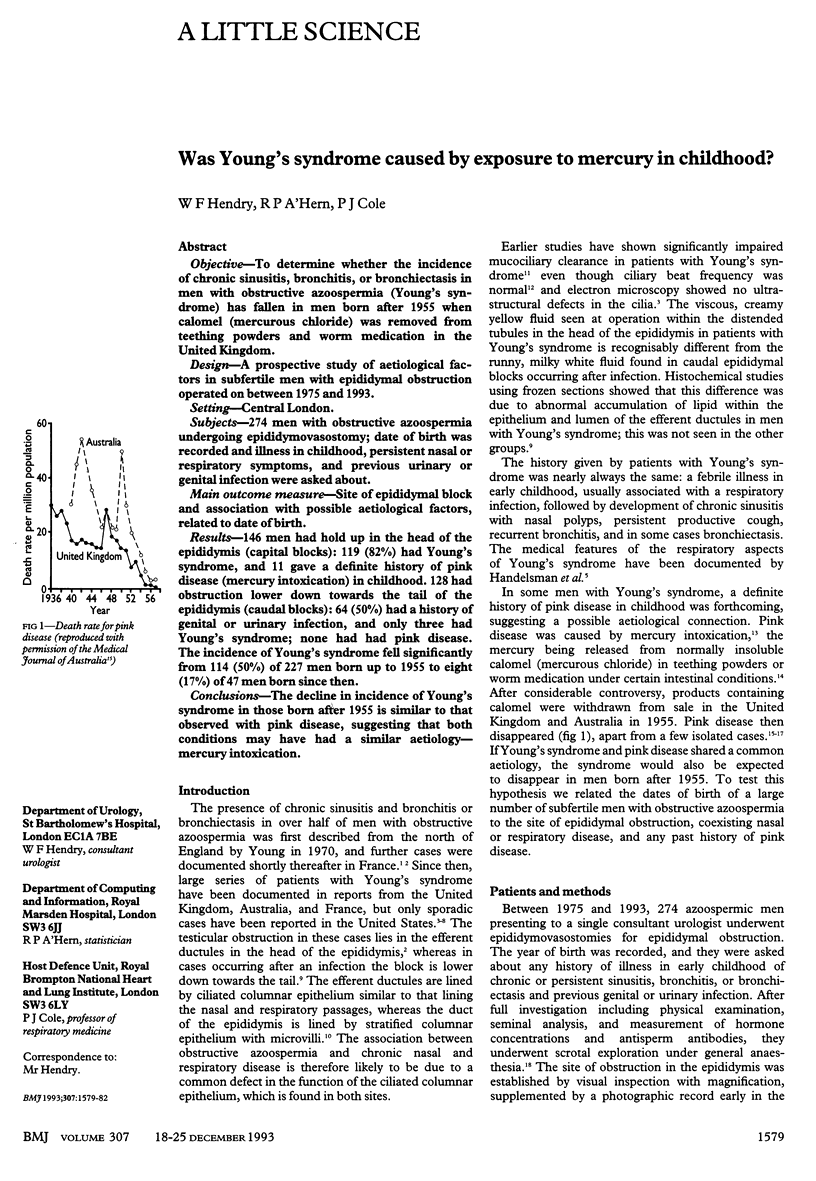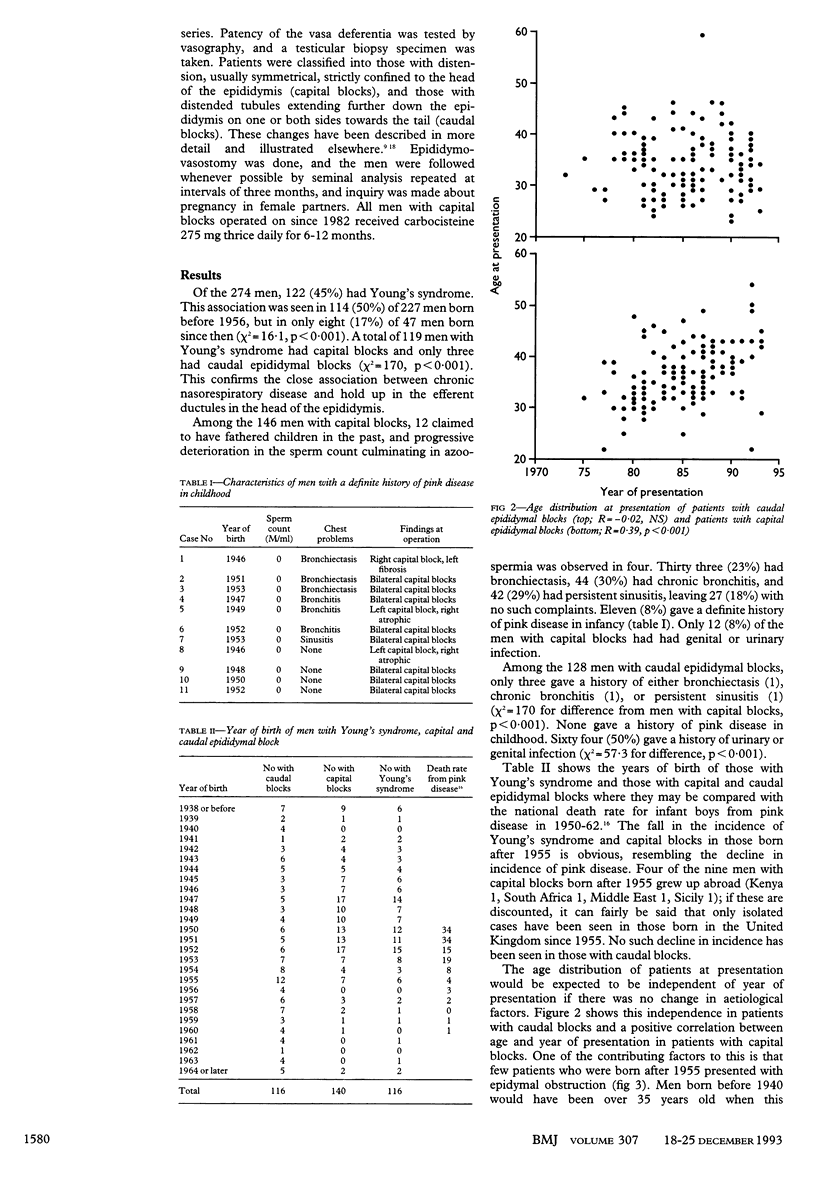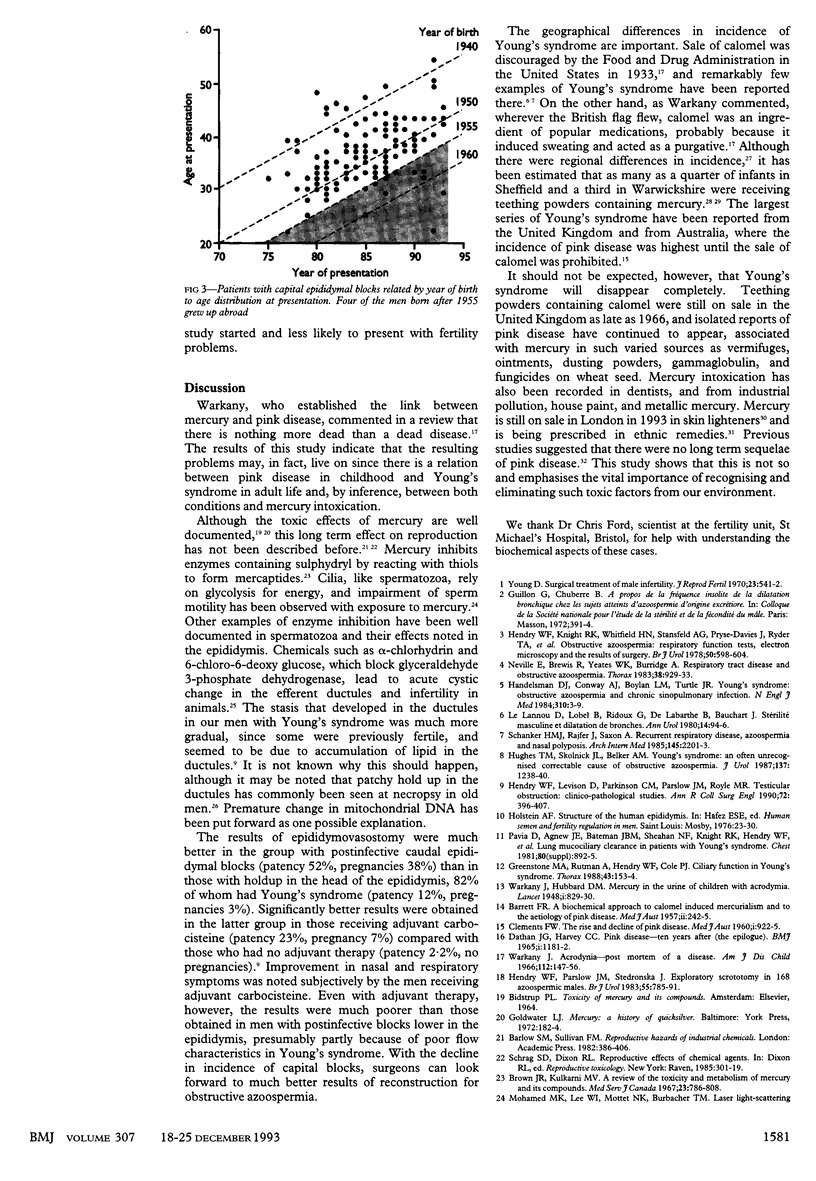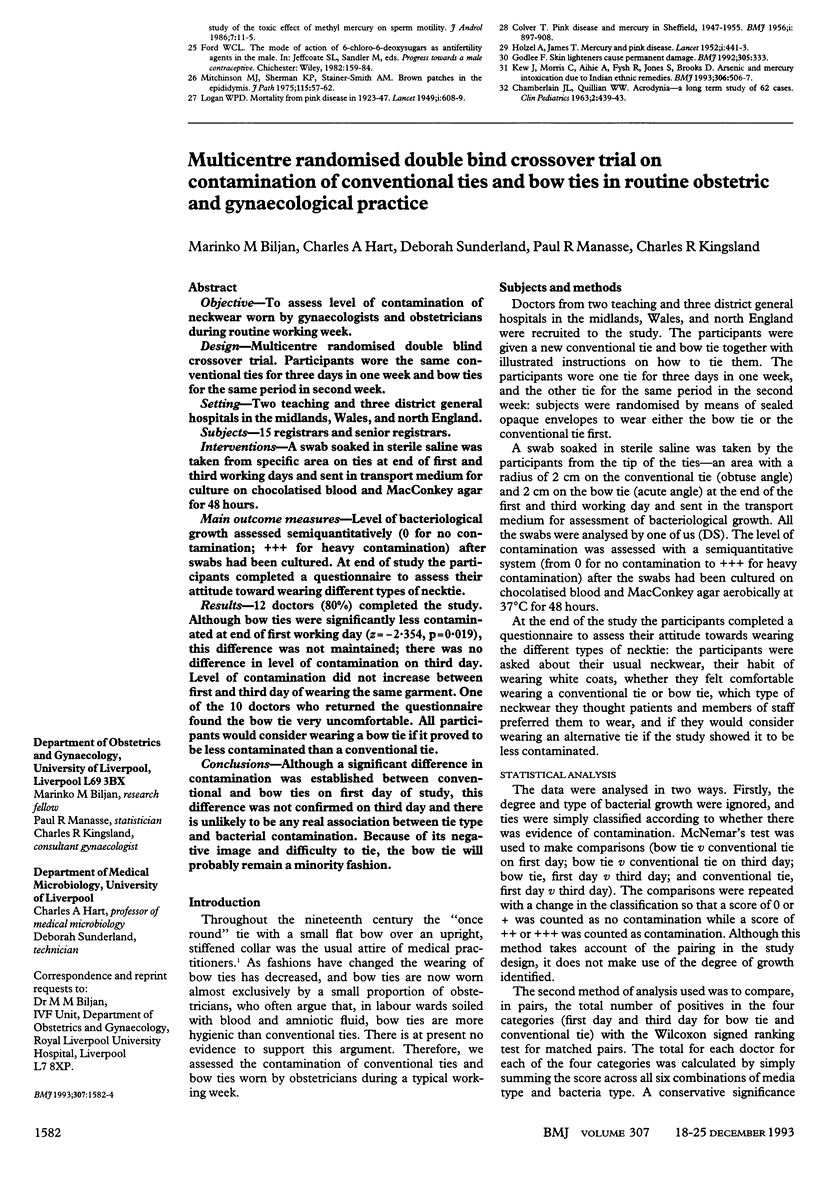Abstract
OBJECTIVE--To determine whether the incidence of chronic sinusitis, bronchitis, or bronchiectasis in men with obstructive azoospermia (Young's syndrome) has fallen in men born after 1955 when calomel (mercurous chloride) was removed from teething powders and worm medication in the United Kingdom. DESIGN--A prospective study of aetiological factors in subfertile men with epididymal obstruction operated on between 1975 and 1993. SETTING--Central London. SUBJECTS--274 men with obstructive azoospermia undergoing epididymovasostomy; date of birth was recorded and illness in childhood, persistent nasal or respiratory symptoms, and previous urinary or genital infection were asked about. MAIN OUTCOME MEASURE--Site of epididymal block and association with possible aetiological factors, related to date of birth. RESULTS--146 men had hold up in the head of the epididymis (capital blocks): 119 (82%) had Young's syndrome, and 11 gave a definite history of pink disease (mercury intoxication) in childhood. 128 had obstruction lower down towards the tail of the epididymis (caudal blocks): 64 (50%) had a history of genital or urinary infection, and only three had Young's syndrome; none had had pink disease. The incidence of Young's syndrome fell significantly from 114 (50%) of 227 men born up to 1955 to eight (17%) of 47 men born since then. CONCLUSIONS--The decline in incidence of Young's syndrome in those born after 1955 is similar to that observed with pink disease, suggesting that both conditions may have had a similar aetiology--mercury intoxication.
Full text
PDF



Selected References
These references are in PubMed. This may not be the complete list of references from this article.
- BARRETT F. R. A biochemical approach to calomel-induced mercurialism and to the aetiology of pink disease. Med J Aust. 1957 Aug 17;44(7):242–245. doi: 10.5694/j.1326-5377.1957.tb57870.x. [DOI] [PubMed] [Google Scholar]
- Brown J. R., Kulkarni M. V. A review of the toxicity and metabolism of mercury and its compounds. Med Serv J Can. 1967 May;23(5):786–808. [PubMed] [Google Scholar]
- CHAMBERLAIN J. L., 3rd, QUILLIAN W. W., 2nd ACRODYNIA. A LONG-TERM STUDY OF 62 CASES. Clin Pediatr (Phila) 1963 Aug;2:439–443. doi: 10.1177/000992286300200808. [DOI] [PubMed] [Google Scholar]
- CLEMENTS F. W. The rise and decline of pink disease. Med J Aust. 1960 Jun 11;47(1):922–925. doi: 10.5694/j.1326-5377.1960.tb78443.x. [DOI] [PubMed] [Google Scholar]
- COLVER T. Pink disease and mercury in Sheffield, 1947-55. Br Med J. 1956 Apr 21;1(4972):897–898. doi: 10.1136/bmj.1.4972.897. [DOI] [PMC free article] [PubMed] [Google Scholar]
- Godlee F. Elderly people abused at home and in care. BMJ. 1992 Feb 8;304(6823):333–333. [PubMed] [Google Scholar]
- Greenstone M. A., Rutman A., Hendry W. F., Cole P. J. Ciliary function in Young's syndrome. Thorax. 1988 Feb;43(2):153–154. doi: 10.1136/thx.43.2.153. [DOI] [PMC free article] [PubMed] [Google Scholar]
- HOLZEL A., JAMES T. Mercury and pink disease. Lancet. 1952 Mar 1;1(6705):441–443. doi: 10.1016/s0140-6736(52)91953-3. [DOI] [PubMed] [Google Scholar]
- Hendry W. F., Knight R. K., Whitfield H. N., Stansfeld A. G., Pryse-Davies J., Ryder T. A., Pavia D., Bateman J. R., Clarke S. W. Obstructive azoospermia: respiratory function tests, electron microscopy and the results of surgery. Br J Urol. 1978 Dec;50(7):598–604. doi: 10.1111/j.1464-410x.1978.tb06221.x. [DOI] [PubMed] [Google Scholar]
- Hendry W. F., Levison D. A., Parkinson M. C., Parslow J. M., Royle M. G. Testicular obstruction: clinicopathological studies. Ann R Coll Surg Engl. 1990 Nov;72(6):396–407. [PMC free article] [PubMed] [Google Scholar]
- Hendry W. F., Parslow J. M., Stedronska J. Exploratory scrototomy in 168 azoospermic males. Br J Urol. 1983 Dec;55(6):785–791. doi: 10.1111/j.1464-410x.1983.tb03426.x. [DOI] [PubMed] [Google Scholar]
- Hughes T. M., 3rd, Skolnick J. L., Belker A. M. Young's syndrome: an often unrecognized correctable cause of obstructive azoospermia. J Urol. 1987 Jun;137(6):1238–1240. doi: 10.1016/s0022-5347(17)44467-3. [DOI] [PubMed] [Google Scholar]
- Kew J., Morris C., Aihie A., Fysh R., Jones S., Brooks D. Arsenic and mercury intoxication due to Indian ethnic remedies. BMJ. 1993 Feb 20;306(6876):506–507. doi: 10.1136/bmj.306.6876.506. [DOI] [PMC free article] [PubMed] [Google Scholar]
- LOGAN W. P. D. Mortality from pink disease in 1923-47. Lancet. 1949 Apr 9;1(6554):608–608. doi: 10.1016/s0140-6736(49)91702-x. [DOI] [PubMed] [Google Scholar]
- Mitchinson M. J., Sherman K. P., Stainer-Smith A. M. Brown patches in the epididymis. J Pathol. 1975 Jan;115(1):57–62. doi: 10.1002/path.1711150110. [DOI] [PubMed] [Google Scholar]
- Mohamed M. K., Lee W. I., Mottet N. K., Burbacher T. M. Laser light-scattering study of the toxic effects of methylmercury on sperm motility. J Androl. 1986 Jan-Feb;7(1):11–15. doi: 10.1002/j.1939-4640.1986.tb00858.x. [DOI] [PubMed] [Google Scholar]
- Neville E., Brewis R., Yeates W. K., Burridge A. Respiratory tract disease and obstructive azoospermia. Thorax. 1983 Dec;38(12):929–933. doi: 10.1136/thx.38.12.929. [DOI] [PMC free article] [PubMed] [Google Scholar]
- Pavia D., Agnew J. E., Bateman J. R., Sheahan N. F., Knight R. K., Hendry W. F., Clarke S. W. Lung mucociliary clearance in patients wit Young's syndrome. Chest. 1981 Dec;80(6 Suppl):892–895. doi: 10.1378/chest.80.6.892. [DOI] [PubMed] [Google Scholar]
- ROSE F. C., SARNER M. SOIL AND STOMACH CANCER. Br Med J. 1965 Jan 2;1(5426):1–2. [PMC free article] [PubMed] [Google Scholar]
- Schanker H. M., Rajfer J., Saxon A. Recurrent respiratory disease, azoospermia, and nasal polyposis. A syndrome that mimics cystic fibrosis and immotile cilia syndrome. Arch Intern Med. 1985 Dec;145(12):2201–2203. [PubMed] [Google Scholar]
- WARKANY J., HUBBARD D. M. Mercury in the urine of children with acrodynia. Lancet. 1948 May 29;1(6509):829–829. doi: 10.1016/s0140-6736(48)91924-2. [DOI] [PubMed] [Google Scholar]
- Warkany J. Acrodynia--postmortem of a disease. Am J Dis Child. 1966 Aug;112(2):147–156. [PubMed] [Google Scholar]


